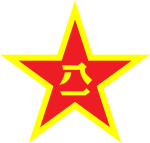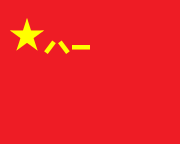
Back Volksbevrydingsleër Afrikaans جيش التحرير الشعبي الصيني Arabic Exércitu Popular de Lliberación AST Çin Xalq Azadlıq Ordusu Azerbaijani Народна-вызваленчая армія Кітая Byelorussian Народна освободителна армия Bulgarian পিপলস লিবারেশন আর্মি Bengali/Bangla Arme Dieubidigezh Pobl Sina Breton Exèrcit Popular d'Alliberament Catalan Dṳ̆ng-guók Ìng-mìng Gāi-huóng-gŭng CDO
| Chinese People's Liberation Army | |||||||||||||||||||||||
|---|---|---|---|---|---|---|---|---|---|---|---|---|---|---|---|---|---|---|---|---|---|---|---|
| Simplified Chinese | 中国人民解放军 | ||||||||||||||||||||||
| Traditional Chinese | 中國人民解放軍 | ||||||||||||||||||||||
| Literal meaning | "China People Liberation Army" | ||||||||||||||||||||||
| |||||||||||||||||||||||
| Armed Forces of the People's Republic of China |
|---|
 |
| Executive departments |
| Staff |
| Services |
| Arms |
| Domestic troops |
| Special operations force |
| Military districts |
| History of the Chinese military |
| Military ranks of China |
 |
|---|
|
|
The People's Liberation Army (PLA) is the armed wing of the Chinese Communist Party (CCP) and the principal military force of the People's Republic of China. The PLA consists of four services — Ground Force, Navy, Air Force, and Rocket Force — and four arms — Aerospace Force, Cyberspace Force, Information Support Force, and Joint Logistics Support Force.[9] It is led by the Central Military Commission (CMC) with its chairman as commander-in-chief.
The PLA can trace its origins during the Republican Era to the left-wing units of the National Revolutionary Army (NRA) of the Kuomintang (KMT) when they broke away in 1927 in an uprising against the nationalist government as the Chinese Red Army, before being reintegrated into the NRA as units of New Fourth Army and Eighth Route Army during the Second Sino-Japanese War. The two NRA communist units were reconstituted as the PLA in 1947.[10] Since 1949, the PLA has used nine different military strategies, which it calls "strategic guidelines". The most important came in 1956, 1980, and 1993.[11] In times of national emergency, the People's Armed Police (PAP) and the China Militia act as a reserve and support element for the Ground Force. Politically, the PLA and PAP are represented in the National People's Congress (NPC) through a delegation of 285 deputies, all of whom are CCP members. Since the formation of the NPC, the joint PLA–PAP delegation has always constituted the largest delegation and today comprises just over 9% of the NPC.[12]
PRC law explicitly asserts the leadership of the CCP over the armed forces of China and designates the CMC as the nationwide military command of the People's Republic of China. The Party CMC operates under the name of the State CMC for legal and governmental functions, and the ceremonial Ministry of National Defense is limited to diplomatic functions. The PLA is obliged to follow the principle of the CCP's absolute civilian control of the military under the doctrine of "the party commands the gun" (Chinese: 党指挥枪; pinyin: Dǎng zhǐhuī qiāng) In this sense, the PLA is not a national army of the type of traditional nation-states, but a political army or the armed branch of the CCP itself since its allegiance is to the party only and not the state or any constitution. At present, the CMC chairman is customarily also the CCP general secretary.
Today, the majority of military units around the country are assigned to one of five theater commands by geographical location. The PLA is the world's largest military force (not including paramilitary or reserve forces) and has the second largest defense budget in the world. China's military expenditure was US$292 billion in 2022, accounting for 13 percent of the world's defense expenditures. It is also one of the fastest modernizing militaries in the world, and has been termed as a potential military superpower, with significant regional defense and rising global power projection capabilities.[13][14]
- ^ "【延安记忆】"中国人民解放军"称谓由此开始". 1 August 2020. Archived from the original on 22 August 2020. Retrieved 22 August 2020.
- ^ "1947年10月10日,《中国人民解放军宣言》发布". 中国军网. 10 October 2017. Archived from the original on 22 August 2020. Retrieved 22 August 2020.
- ^ "中国共产党领导的红军改编为八路军的背景和改编情况 – 太行英雄网". Archived from the original on 7 January 2022. Retrieved 7 January 2022.
- ^ Cite error: The named reference
:4was invoked but never defined (see the help page). - ^ a b The International Institute for Strategic Studies 2022, p. 255.
- ^ a b Tian, Nan; Fleurant, Aude; Kuimova, Alexandra; Wezeman, Pieter D.; Wezeman, Siemon T. (24 April 2022). "Trends in World Military Expenditure, 2021" (PDF). Stockholm International Peace Research Institute. Archived from the original on 25 April 2022. Retrieved 25 April 2022.
- ^ Xue, Maryann (4 July 2021). "China's arms trade: which countries does it buy from and sell to?". South China Morning Post. Archived from the original on 26 May 2022. Retrieved 26 May 2022.
- ^ a b "TIV of arms imports/exports from China, 2010–2021". Stockholm International Peace Research Institute. 7 February 2022. Archived from the original on 21 June 2023. Retrieved 26 January 2023.
- ^ "Chinese PLA embraces a new system of services and arms: Defense spokesperson - China Military". eng.chinamil.com.cn. Retrieved 20 April 2024.
- ^ Cite error: The named reference
Benton-1999was invoked but never defined (see the help page). - ^ Fravel, M. Taylor (2019). Active Defense: China's Military Strategy since 1949. Vol. 2. Princeton University Press. doi:10.2307/j.ctv941tzj. ISBN 978-0-691-18559-0. JSTOR j.ctv941tzj. S2CID 159282413.
- ^ "第十三届全国人民代表大会代表名额分配方案" [Allocation Plan for Deputies to the Thirteenth National People's Congress]. National People's Congress (in Chinese). 27 April 2017. Archived from the original on 26 June 2017.
- ^ International Institute for Strategic Studies (2020). The Military Balance. London: Routledge. p. 259. ISBN 978-0367466398.
- ^ "Global military spending remains high at $1.7 trillion". Stockholm International Peace Research Institute. 2 May 2018. Archived from the original on 27 May 2018. Retrieved 13 October 2018.
© MMXXIII Rich X Search. We shall prevail. All rights reserved. Rich X Search

